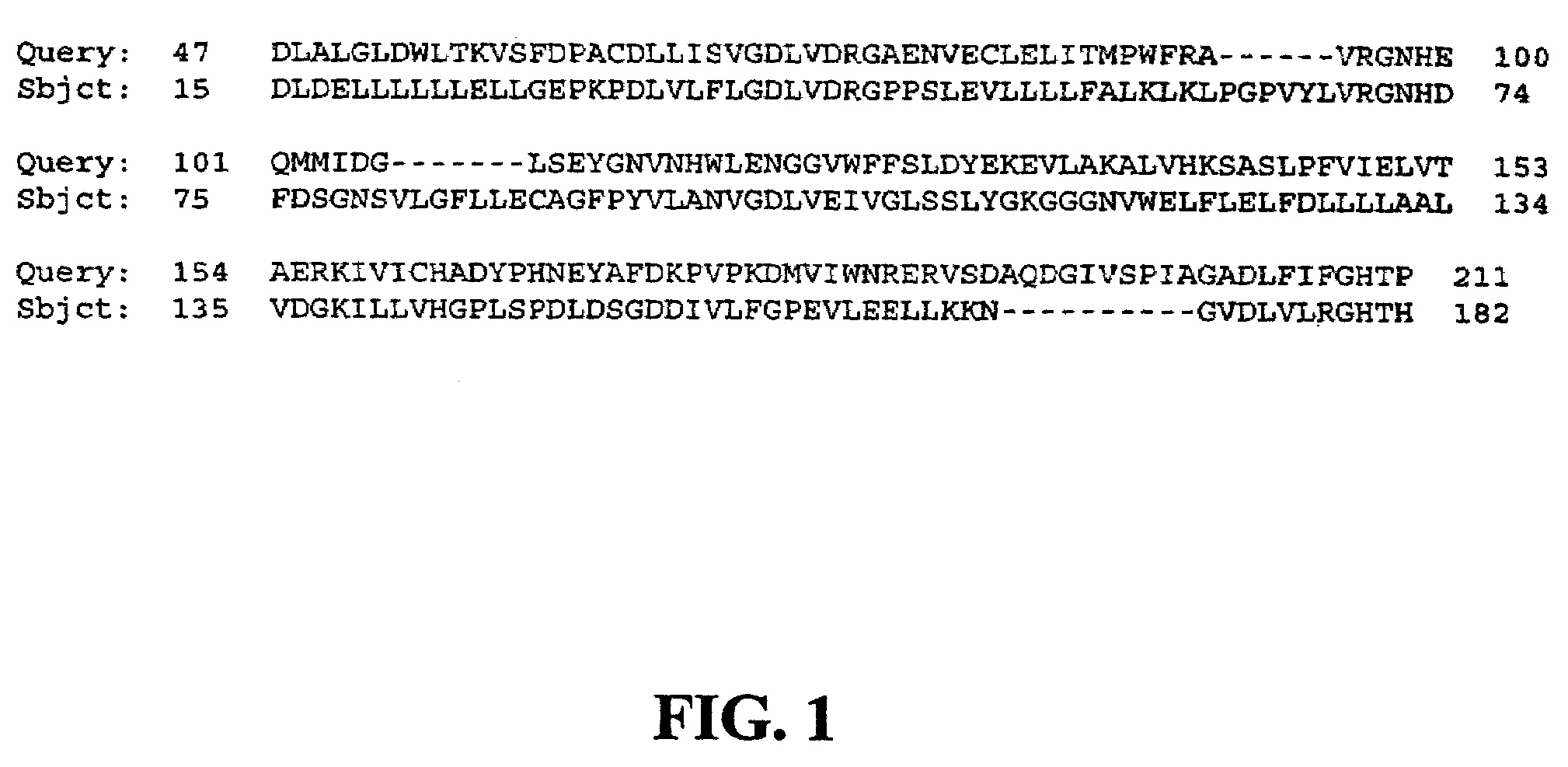Compositions employing a novel human protein phosphatase
a human protein and phosphatase technology, applied in biochemistry, organic chemistry, biochemistry apparatus and processes, etc., can solve the problems of high detrimental changes in these regions, and achieve the effect of inhibiting clpp1 gene expression
- Summary
- Abstract
- Description
- Claims
- Application Information
AI Technical Summary
Benefits of technology
Problems solved by technology
Method used
Image
Examples
example 1
Identification of CLPP1 Sequence in Human Genome Database
[0232]The nucleic acid sequence of CLPP1 is obtained from a newly developed genomic prediction pipeline. Briefly, the X-ray crystal structures of the catalytic domains of protein phosphatase were collected and aligned together according to their structural identity / similarities. The alignment was converted into a “scoring matrix” which carried the structural profile of the phosphatase catalytic domains. This scoring matrix was then used to search the Celera Human Genome database for sequences that have phosphatase catalytic domains.
example 2
BLAST Analysis
[0233]Sequence alignments between CLPP1 and other sequences in GenBank database were performed using the standard protein-protein BLAST(blastp), standard nucleotide-nucleotide BLAST(blastn), BLAST2 Sequences, and human genome BLAST programs that are available at NCBI's BLAST website.
[0234]A standard protein-protein BLAST search in the “nr” database (available at NCBI's BLAST website) with “Filter” setting unchecked, “Expect” setting at 10.0, “Word Size” setting at 3, “Matrix” setting at BLOSUM62, “Gap costs” setting at Existence:11 and Extension:1, revealed that CCPP1 is identical to a hypothetical human protein LOC159669 (Entrez accession number: XM100270), which was predicted from NCBI contig NT024115 by automated computational analysis using gene prediction method GenomeScan. In addition, CLPP1 also share sequence homologies to a number of proteins, including but are not limited to, Bacteriophage lambda ser / thr protein phosphatase (Entrez accession number: P03772, 7...
example 3
Hydrophobicity Analysis
[0239]The hydrophobicity profile of CLPP1 sequence (FIG. 2) was generated using the GES (Goldman, Engelman and Steitz) hydrophobicity scale (Engelman et al., Ann. Rev. Biophys. Biophys. Chem. 15:321–353, 1986.) Briefly, the GES scale is used to identify nonpolar transbilayer helices. The curve is the average of a residue-specific hydrophobicity scale over a window of 20 residues. When the line is in the upper half of the frame (positive), it indicates a hydrophobic region and when it is in the lower half (negative), a hydrophilic region.
[0240]In FIG. 2, the X-axis represents the length of the protein in amino acids (aa), while the Y-axis represents the GES score. The curve line shows the GES pattern of the entire protein, while the strait line represents certain cutoff for potential membrane spanning domains. The hydrophobicity profile indicates that CLPP1 is probably not a membrane protein.
[0241]Having described preferred embodiments of compositions, organism...
PUM
| Property | Measurement | Unit |
|---|---|---|
| Tm | aaaaa | aaaaa |
| pH | aaaaa | aaaaa |
| catalytic properties | aaaaa | aaaaa |
Abstract
Description
Claims
Application Information
 Login to View More
Login to View More - R&D
- Intellectual Property
- Life Sciences
- Materials
- Tech Scout
- Unparalleled Data Quality
- Higher Quality Content
- 60% Fewer Hallucinations
Browse by: Latest US Patents, China's latest patents, Technical Efficacy Thesaurus, Application Domain, Technology Topic, Popular Technical Reports.
© 2025 PatSnap. All rights reserved.Legal|Privacy policy|Modern Slavery Act Transparency Statement|Sitemap|About US| Contact US: help@patsnap.com


